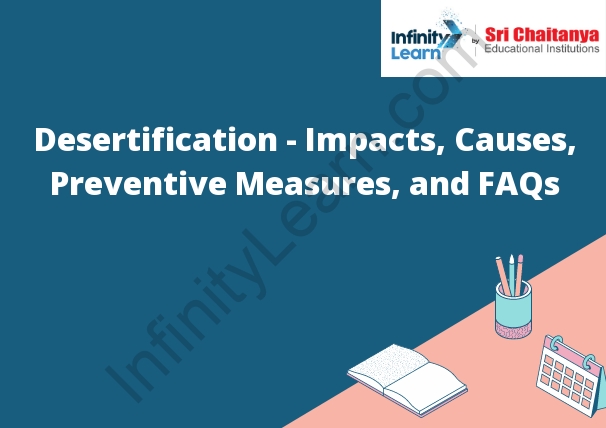Table of Contents
Desertification Meaning
Desertification – Impacts: Desertification is the process of land degradation in arid, semi-arid and dry sub-humid areas, resulting in the loss of natural vegetation and degradation of soils. The phenomenon is caused by a variety of factors, including climatic variations and human activities.
The main causes of desertification are:
- Climatic variations: Droughts and extreme temperatures can lead to the loss of vegetation and degradation of soils.
- Human activities: Deforestation, overgrazing, improper irrigation and mining can lead to desertification.
- The effects of desertification include:
- Soil erosion: The loss of vegetation leads to the loss of soil cover, which increases the susceptibility of soils to erosion.
- Land degradation: The loss of soil fertility, the formation of sand dunes and the loss of water resources can lead to the degradation of land.
- Displacement of people: Desertification can lead to the displacement of people as they are forced to abandon their homes in search of arable land.
- Reduction in food production: Desertification can lead to a reduction in food production as a result of the loss of vegetation and soil fertility.

Impacts of Desertification
Desertification is the process of land degradation in arid, semi-arid and dry sub-humid regions, resulting in the loss of biological productivity and diversity. It is caused by a variety of factors, including climatic variations and changes in land use.
Some of the impacts of desertification include:
- Soil erosion – Wind and rain can quickly erode unprotected soil, leading to the loss of valuable topsoil.
- Diminished water resources – As the land becomes increasingly arid, the amount of water available for plants and animals diminishes. This can lead to a decrease in crop yields, increased water needs, and a decline in the local water table.
- Reduced wildlife populations – As the land becomes less hospitable, the populations of plant and animal species decline. This can have a significant impact on the local ecosystem.
- Increased wildfires – Drier conditions can lead to an increase in the number of wildfires.
- Increased poverty – As the land becomes less productive, the local population often becomes poorer. This can lead to a decline in the standard of living and increased food insecurity.
Causes of Desertification
Desertification is a gradual process of transforming fertile land into desert. Causes of desertification are numerous and include climate change, deforestation, overgrazing, and drought.
Desertification is the process of land degradation in arid, semi-arid, and dry sub-humid areas due to various factors, including climatic variations and human activities. Desertification is a global environmental problem. It is estimated that 1.5 billion people are living in areas affected by desertification.
The major factors that lead to desertification are:
- Climatic variations: Climatic variations, such as drought and increased temperature, contribute to the process of desertification.
- Human activities: Human activities, such as deforestation, overgrazing, and improper land use, contribute to the process of desertification.
- Soil erosion: Soil erosion, caused by wind and water, contributes to the process of desertification.
- Degradation of land: Degradation of land, caused by mining, drilling, and other industrial activities, contributes to the process of desertification.
- Lack of water: Lack of water, due to the depletion of water resources and the increase in water demand, contributes to the process of desertification.
Measures to Prevent Desertification
There are many measures that can be taken to prevent desertification, including:
- Establishing protected areas and parks that are off-limits to development and human activity.
- Regulating and managing water use in order to prevent overdraft and soil erosion.
- Improving irrigation systems and using water more efficiently.
- Planting trees and other vegetation to stabilize the soil and create shade.
- Restoring damaged ecosystems and repairing erosion damage.
- Promoting sustainable land management practices, such as rotational grazing and agroforestry.
- Educating local communities about the dangers of desertification and how they can help to prevent it.







